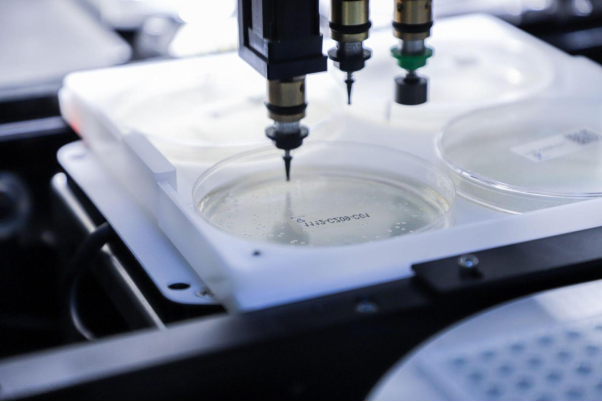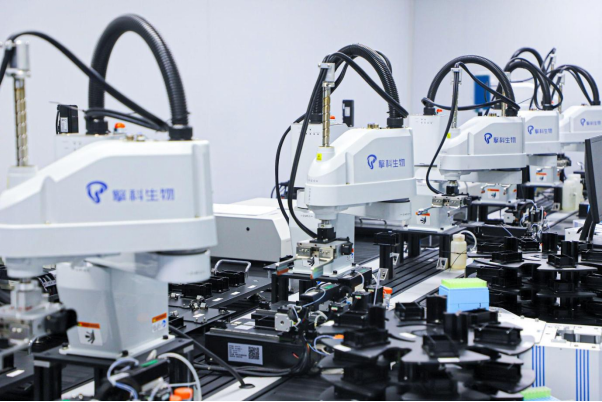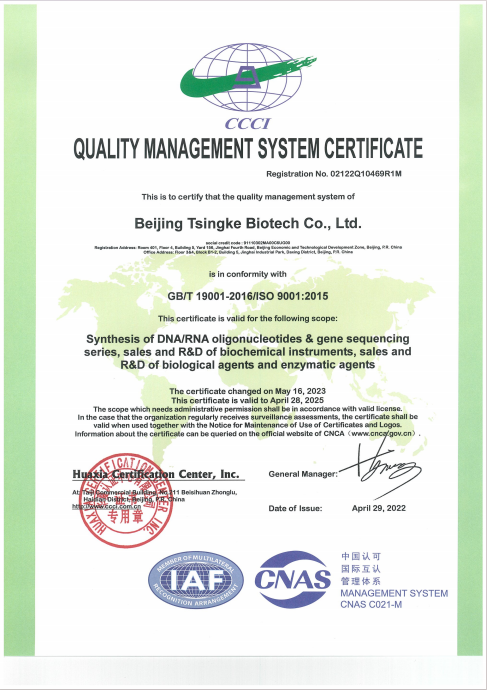Gene synthesis is the process of synthesizing specific double-stranded DNA molecules using chemical or biological methods in the laboratory. Compared to obtaining genes from organisms, artificial gene synthesis doesn’t need template DNA and theoretically allows for synthesizing DNA molecules with no restrictions on nucleotide sequence or size.
The first artificial synthetic gene appeared in 1972 by Har Gobind Khorana and coworkers. (Wikipedia, 2024) This technology is a revolutionary advance in modern bioscience that allows scientists to design and construct genes, promoting the development of various fields such as genetic engineering, drug discovery, synthetic biology, and protein expression research.
For example, it can be used to produce new proteins and enzymes for medicine and industry, as well as to research genetically modified organisms to alter crop characteristics. In conclusion, gene synthesis plays an important role in modern biological science and offers new possibilities for our understanding of life.

Applications of Gene Synthesis
Gene synthesis technology is widely used in the biomedical field. From antibody drug discovery and vaccine development to gene and cell therapy, artificial gene synthesis plays an important role.
1. Antibody Drug Discovery
Gene synthesis is important in antibody drug discovery. Antibody, also known as immunoglobulins, is the protein produced by B lymphocytes that can recognize and bind to specific antigens, causing immune effects.
Traditional antibody production depends on immunizing animals or cells, which is a complex and inefficient process.
Gene synthesis technology, on the other hand, allows for synthesizing specific antibody genes, which are cloned and expressed in various host cells, such as bacteria and mammalian cells. Recombinant antibodies produced by host cells will undergo purification and quality control. This method can precisely control antibody characteristics to meet specific diagnostic and research needs. (Frenzel, Hust and Schirrmann, 2013, p.51304)
2. Cell Therapy
Cell therapy is a treatment method that utilizes biotechnological means to obtain cells with specific functions. The new cells can replace damaged cells or cause stronger immune effects to treat diseases. It revolutionized the treatment of intractable diseases such as cancer. The main types of cell therapy are immune cell therapy and stem cell therapy.
Gene synthesis can support the screening and optimization of candidate molecules, CRISPR/Cas-related research, cell modification, etc.
3. Gene Therapy
Gene therapy refers to the insertion of exogenous normal genes into target cells to replace or repair faulty genes that cause diseases. Gene therapy is expected to fundamentally change genetic diseases and bring hope to cancer patients.
Gene synthesis technology helps to synthesize target genes and vectors. This precise synthetic sequence can improve the efficiency and accuracy of gene therapy.
4. Vaccine
Vaccines are an important method of preventing infectious diseases and certain cancers. Traditional vaccine production requires large amounts of pathogens, and the production process is complex and inefficient.
Gene synthesis can be applied to the development of nucleic acid vaccines, such as the rapid and precise creation of DNA or RNA sequences encoding antigens. (World Health Organization, 2007). When these nucleic acids are introduced into the body, cells recognize the genetic information and produce antibodies.
In addition, gene synthesis can be used in the development of recombinant protein vaccines. By using synthetic genes to express key proteins of pathogens in an expression system (such as bacterial or mammalian cells), the immune system can be stimulated to produce antibodies against that pathogen.
Gene synthesis has greatly accelerated vaccine development and improved the safety and stability of vaccines.

Technological Advances
Recent research and technological advances show that gene synthesis is driving innovation and development in various fields. For example, the new GRAND gene editing tool, which enables precise targeted insertion of large DNA fragments, has expanded the scope of genome editing and has great potential for treating genetic diseases. (Wang et al, 2022, pp, 331–340)
Significant breakthroughs have also been made in large-fragment gene synthesis and assembly. For instance, Tsingke Gene Factory is capable of delivering DNA fragments up to 200 kb in length, providing solutions for developing new drugs, optimizing disease treatments, and solving environmental problems.
Moreover, enzymatic DNA synthesis has also entered a new phase. Conventional DNA synthesis relies mainly on chemical synthesis with limited length. If the core principles of enzymatic synthesis are proven, the ability to synthesize long DNA strands quickly, accurately, and with high throughput could be transformative. (Eisenstein, 2020, pp, 1113–1116)
Ethical and Safety Issues
US:
In the United States, the regulatory approach for specific products depends on their intended use (i.e. as food, medicine, or pesticide) or characteristics (i.e. as plant pests).
The FDA encourages genetically modified crop developers to voluntarily consult the FDA before going to market and share information that the company believes indicates that genetically modified foods and any additives are safe.
Moreover, pesticidal proteins expressed in genetically modified crops without prior approval from the EPA shall not be tested on-site on more than 10 acres of land by developers and shall not be put into commercial use until the EPA approves that they will not cause unreasonable adverse effects on the environment.
Food additives can only be approved when they are considered safe by the FDA (defined by law as "reasonable certainty of no harm"). (StartUs Insights, 2023)
EU:
The EU has taken a more cautious approach to approving the commercialization of gene synthesis products. Firstly, according to EU rules, organisms whose genetic material is modified in a way that does not occur naturally through mating and/or natural recombination must undergo mandatory pre-market evaluations.
In addition, to ensure food safety and environmental risks, before planting genetically modified crops, applicants need to provide information on the structure and expression of the inserted material, as well as intended trait stability, a toxicological assessment, a potential allergenicity assessment, and a nutritional assessment to address the impact of genetically modified crops on human and animal health. (National Academies of Sciences, 2016)
Cannada:
Canada focuses more on new food and plant traits rather than specific breeding processes or product categories. The Canadian regulatory system follows a process-neutral approach. The government is more concerned about risks, which is the potential exposure to new food or the environment. This means that the characteristics of new organisms cannot have potential harm to the environment.
In addition, any new major crop variety must obtain prior approval from the CFIA's Variety Registration Office after review by an advisory committee composed of representatives from public and private institutions, ensuring that it is at least of the same quality as existing varieties. (Smyth, 2017, pp.35-43)
Brazil:
The Brazilian government has established a technical organization for risk assessment of genetically modified foods and crops: the CTNBio. It mainly evaluates the food safety and environmental risks of genetically modified foods and crops. If there are adverse effects, CTNBio reserves the right to suspend or revoke the environmental release authorization for genetically modified crops and their by-products.
The Brazilian Ministry of Justice has issued implementation rules requiring food with a genetically modified content exceeding 1.0% to carry a specific transgenic logo, which is the capital "T" in the yellow triangle. Violation of biotechnology regulations will result in civil and criminal penalties. (National Academies of Sciences, 2016)
Overall, regulations on genetically modified products, genetically modified foods, and crops in various countries are mainly formulated around food safety and environmental risks. However, there are differences in the methods and policies related to risk management and acceptable risk levels.
After obtaining approval for genetically modified crops, continuous monitoring or control will be required to eliminate risks that affect the environment and human health.
The main regulatory approach is not based on the breeding process but on novelty, potential hazards, and exposure as standards to ensure that new crops do not pose a threat to human health.
Future Outlook
In the future, gene synthesis technology will continue to develop towards high-throughput, high-precision, and low-cost methods to realize the synthesis of longer fragments of DNA.
Advanced gene editing tools, such as the CRISPR-Cas system, are being improved to improve accuracy and reduce off-target interactions. The improvement of gene editing accuracy can also ensure more predictable cellular behaviors.
Sequencing techniques such as NGS will be improved to quickly sequence large amounts of DNA. In addition, the integration of fermentation technology and the utilization of mycoproteins provide alternative ways for protein production. (StartUs Insights, 2023)
However, the transnational nature of biotechnology research makes it difficult for scientists and companies to comply with different regulatory norms in different countries. In addition, regulating biotechnology through export controls poses significant challenges. Because scientific research is open and collaborative, strict export controls will only inhibit research and development. (StartUs Insights, 2023)
This means that only important participants in the field of biotechnology can collaborate to play a regulatory role
Tsingke's Gene Synthesis Services
Tsingke is equipped with an intelligent gene synthesis line to provide high-quality, efficient, and cost-effective plasmids up to 200kb in length.
Clients can select from over 160 commercial vectors and benefit from complimentary codon optimization services, ensuring the optimal expression of both prokaryotic and eukaryotic genes. Every plasmid undergoes meticulous NGS and Sanger sequencing.
Moreover, leveraging a sophisticated nucleic acid sequence optimization algorithm, Tsingke streamlines sequence synthesis complexities while enhancing protein expression. With a turnaround time of just 5 days, obtaining the desired synthesized gene is swift and hassle-free.
Conclusion
Gene synthesis technology will undoubtedly continue to drive innovation in a variety of fields, including medicine, agriculture, and biotechnology.
Tsingke is excited to be a key player in this advancement, providing researchers with the most accurate synthesis solutions available. Contact us to learn more about gene synthesis and to customize the gene fragments you need!
References
Eisenstein, M., 2020. Enzymatic DNA synthesis enters a new phase. Nature biotechnology, 38(10), pp.1113-1116.
Frenzel, A., Hust, M. and Schirrmann, T., 2013. Expression of recombinant antibodies. Frontiers in immunology, 4, p.51304.
National Academies of Sciences, Engineering, and Medicine; Division on Earth and Life Studies; Board on Agriculture and Natural Resources; Committee on Genetically Engineered Crops: Past Experience and Future Prospects. Genetically Engineered Crops: Experiences and Prospects. Washington (DC): National Academies Press (US); 2016 May 17. 9, Regulation of Current and Future Genetically Engineered Crops. Available from: https://www.ncbi.nlm.nih.gov/books/NBK424533/ (Accessed: 17 May 2024)
Smyth, S.J., 2017. Canadian regulatory perspectives on genome engineered crops. GM crops & food, 8(1), pp.35-43.
StartUs Insights. (2023) Explore the Top 10 Synthetic Biology Trends in 2024 [Online]. Available at: https://www.startus-insights.com/innovators-guide/synthetic-biology-trends/ (Accessed: 17 May 2024)
Wikipedia. (2024) Artificial gene synthesis [Online]. Available at: https://en.wikipedia.org/wiki/Artificial_gene_synthesis. (Accessed: 17 May 2024)
World Health Organization. (2007) DNA vaccines [Online]. Available at: https://www.who.int/teams/health-product-policy-and-standards/standards-and-specifications/vaccines-quality/dna. (Accessed: 17 May 2024)
Wang, J., He, Z., Wang, G., Zhang, R., Duan, J., Gao, P., Lei, X., Qiu, H., Zhang, C., Zhang, Y. and Yin, H., 2022. Efficient targeted insertion of large DNA fragments without DNA donors. Nature methods, 19(3), pp.331-340.







